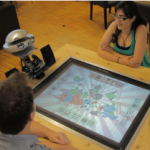About the project
Objective
This project aims to understand better how people assess safety in a particular area of Stockholm – Järva, more specifically, how people’s safety perceptions relate to the quality of the physical and social environment of the area. We investigate the nature of safety on two fronts: an intra-area focus where we examine micro-level safety perceptions by people living and working in Järva and a city-wide focus where we explore ways to capture how people living elsewhere in Stockholm perceive Järva. The research will combine multiple sensors and data types, including phone apps, map-based surveys, and machine-learning models.
Background
Safety is a core component of people’s quality of life, affecting physical and mental health and restricting mobility and accessibility to public places. As such, safety is also a fundamental quality of the urban environment – what happens in places depends on how safe they are (or are perceived to be). Research has long pointed to the fact that indicators of poor maintenance or signs of physical deterioration are more important determinants of poor safety perceptions than actual instances of crime. The buildings’ façades, design, and the sense of ownership they promote are bound to affect crime and safety. Hence, some questions arise: which settings promote safety and for whom? What do these settings look like from a safety perspective?
Järva constitutes an interesting case study for several reasons: the area is undergoing great growth in the coming years – with more than 15,000 housing units being developed, new transportation links, workplaces and schools. However, a significantly higher share of Järva’s population feels unsafe outdoors at night and is more likely to avoid certain places where they live than the Stockholm average. In a previous study where Stockholm citizens were asked to assess Google Street View images regarding safety, the findings showed that the physical environment in Järva was ranked the lowest across Stockholm. Therefore, this project seeks to produce several diagnostics of the safety conditions in Järva and contribute to a better understanding of the spatiotemporal variations of the population’s safety perceptions.
Crossdisciplinary collaboration
Sensoring Safety Perceptions is a collaboration between research teams at KTH and MIT Senseable City Lab (part of the Stockholm Senseable Lab), as well as Stockholm City, Mapita (Maptionnaire), Kista Science City, and CityCon, and other local stakeholders based in the study area.
Watch the recorded presentation at the Digitalize in Stockholm 2023 event:
About the project
Objective
The vision of the proposed project is to establish a framework for dynamically optimized traffic control with a view to reduce the negative impact associated with the transport system in dense urban areas, including congestion, pollutants and noise emissions. For this purpose, the research will consist of assembling a sensor network in Stockholm collecting and processing traffic and emission data. The data will feed a set of advanced modelling tools in order to develop multilayer visualisation and simulation models.
Background
With an estimated 55% of the world’s population residing in urban environments, with projections reaching 68% by 2050, exposure to high noise levels and other environmental factors, such as air pollution, is a growing concern. In this context, the concept of smart cities has emerged to respond to the challenge of quality of living and sustainable development of these urban environments. In particular, the digitalization of society provides an opportunity to assess the exposure to these environmental stressors better to identify root causes for which targeted mitigation strategies may be specifically implemented. This may be even more so when approaching near real-time capability, opening the way for dynamic solutions.
The GEOMETRIC project seeks to contribute to this need by implementing and demonstrating recent state-of-the-art research aiming at real-time representation of traffic and associated environmental stressors in dense urban environments.
Crossdisciplinary collaboration
GEOMETRIC is a collaboration between the City of Stockholm, Kista Science City, and three research teams at KTH with expertise in Sound and Vibration, Connected transport systems, and Geoinformatics.
Watch the recorded presentation at the Digitalize in Stockholm 2023 event:
About the project
Objective
This project will address interactions with novel conversational systems, such as social robots and digital assistants. These technologies can assist people in societal situations such as health care, elderly care, education, public spaces and homes.



A telepresence system for human-robot interaction will be developed, allowing participants to situate themselves in natural conversations while physically in a functional magnetic resonance imaging scanner. Each participant will interact directly with a human-like robot and other human actors while lying in the scanner.
This neuroimaging experiment will allow us to understand cognitive processes underlying engagement. It will also enable an unheard-of in-depth evaluation and perception of conversational engagement as a user state.
Background
In everyday conversations, a speaker and a listener are involved in a common project that relies on close coordination, requiring each participant’s continuous attention and related engagement. At the same time, additional bystanders might show less engagement in the conversation.
Previous research in human-human and human-robot interaction has identified four types of events establishing engagement involving gesture and speech: (1) joint directed gaze at objects, (2) mutual facial gaze, (3) back-and-forth conversation, (4) short feedback such as nods while the speaker is talking. We will study the underlying neural signatures of conversational engagement.
Crossdisciplinary collaboration
The researchers in the team represent the Department of Intelligent Systems at KTH EECS, the Psychology Department and the Linguistics Department at Stockholm University.
Watch the recorded presentation at the Digitalize in Stockholm 2023 event:
About the project
Objective
This research project aims to design a threat modelling and attack simulation language, insuranceLang, for cyber insurance. Testing and validating the domain-specific language will be done using data from the insurance industry. Cyber insurances are fairly new, and their models are simplistic and highly generalized. One reason for this is the lack of relevant historical data on insured losses. As a consequence, cyber insurance is probably not used optimally. In particular, some industries cannot offer appropriate insurance coverage because their risks cannot be assessed.
Background
Society is getting more digitalized. This entails great opportunities but also novel cyber risks, which can be difficult to assess. An adequate understanding of cyber risk is crucial since cybersecurity is a prerequisite for successful industrial transformation and digitalization. Thus, there is great potential for overcoming some of these cyber insurance challenges. More precisely, the use of attack simulations based on system architecture (threat) models is a promising avenue for analyzing the cybersecurity posture of a system. Suppose such analyses were to become more widely used by insurers. In that case, that could enable more precise risk assessment, a better understanding of risk-reducing measures, and insights into risks that have been uninsurable until now.
Crossdisciplinary collaboration
The researchers in the team represent the School of Electrical Engineering & Computer Science, KTH and the Division of Digital Systems, RISE.
In addition to the PIs, Carlos Barreto works in this project as a postdoctoral researcher funded by Digital Futures.
Watch the recorded presentation at Digitalize in Stockholm 2022 event:
About the project
Objective
SOS (Smart Och Säker) will enable users to securely store data in confidential cloud enclaves as well as automate the interaction between Internet of Things (IoT) devices via provably secure IoT apps. To achieve these goals, SOS will leverage the support for confidential computing in commodity server platforms, thereby providing end-users with a protected execution environment on third-party clouds. Building on these technologies, SOS will also help ensure that data is not unintentionally or maliciously leaked to unauthorized third parties. Finally, to demonstrate feasibility in realistic societal contexts, SOS will focus on two prime domains: telecare and distance education.
Background
Use of cloud-based IoT apps ensures on-demand computing and storage provisioning. However, this comes at the price of entrusting potentially sensitive data to a range of third-parties that constitute the cloud back-end: app developers, services running the IoT apps in the cloud, as well as the underlying cloud providers. The cloud computing paradigm entails further security and privacy concerns as data is often handled by a range of third-party sub processors. Besides operational aspects, the IoT platform operators that process data on cloud premises can be compromised, go bankrupt or be purchased by a competitor, along with all the collected data. Finally, the power of IoT apps can be abused by attackers.
Crossdisciplinary collaboration
The researchers in the team represent the School of Electrical Engineering & Computer Science, KTH and the Cybersecurity Unit, RISE.
Watch the recorded presentation at Digitalize in Stockholm 2022 event:
About the project
Objective
This research project will provide the foundations for Resilient Decentralized Computing: a new approach to rapidly build continuous, trusted and scalable applications with built-in resilience and privacy. While state-of-the-art cloud technologies require low-latency reliable networks at their core, the project proposes a decentralized computing abstraction inspired by biological structures, called “PODS”, which enables resilience and privacy even in decentralized networks of heterogeneous, often faulty devices that are geo-distributed and only partially online. PODS will be supported by a new programming system which will guarantee data consistency and privacy at compile time, even before software is executed.
Background
The prominent interest in big data technologies and cloud computing has led to significant advancements in how we can reliably store, process and provision data in controlled environments. These include managed data centers, that isolate human users from handling failure outbreaks and data consistency errors. In the context of smart cities and edge services, however, the majority of computing occurs at the “outskirts” of cloud data centers, namely the edge. Currently, the same level of maturity and isolation is yet to be reached in general-purpose software components that operate continuously outside managed cloud environments, yet encapsulate critical logic and actuation to real-world events. Creators and users of cloud and edge services today constantly face unintuitive complexities relating to data consistency, resilience to failures, scalability and privacy while working with non-declarative and low-level programming interfaces.
Crossdisciplinary collaboration
The researchers in the team represent the School of Electrical Engineering & Computer Science, KTH and the Division of Computer systems, RISE.
Watch the recorded presentation at Digitalize in Stockholm 2022 event:
About the project
Objective
This project will produce a landmark, large-scale qualitative study of the first algorithmic contraceptive on the market. Natural Cycles offers an algorithmic contraceptive option to more than 700,000 users worldwide. This provides an excellent testbed for studying how trust is developed, experienced, and maintained between primary and secondary users as well as an algorithmic health service. Crucial insights will be gained into e.g. the mechanisms by which users choose to trust and continue trusting an algorithmic digital health technology, with a focus on psychological, contextual and interpersonal factors.

Background
Algorithmic systems and Artificial Intelligence (AI) are poised to disrupt how we deliver and experience healthcare, providing new solutions to personal and public health issues. Trust has been identified as one key foundation for the success of digital health technologies. Mechanisms that promote trust are critical areas for research and innovation. Health interventions are often designed for use – and behaviour change – at an individual level. However, health choices, health behaviours, and critically trust in healthcare service providers are interpersonal and socially constructed. This calls for research on trust in health technologies engaging with the wider social context of ‘use’ when examining how trust is developed and maintained.

Crossdisciplinary collaboration
The researchers in the team represent the School of Electrical Engineering & Computer Science, KTH, and the Department of Computer and Systems Sciences (DSV), Stockholm University.
Watch the demo video of IntimateHealth here:
